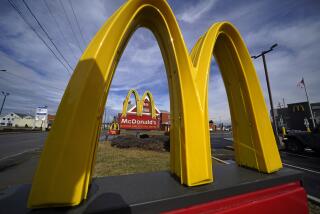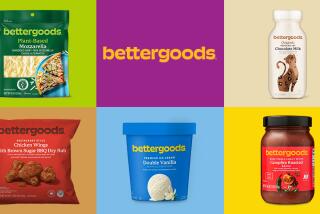Shoppers Dropping Name Brands to Pick Up Change
- Share via
CHICAGO — Cheerios or Wheat-Os? President’s Choice chocolate chip cookies or Chips Ahoy? Tide or Rinso? When it’s time to buy, a growing number of consumers are showing more loyalty to their pocketbooks than to brand names, a recent survey found.
The Food Marketing Institute’s annual consumer trends survey found a 19% increase in the number of shoppers who are buying lower-priced or store brands, a trend that doesn’t bode well for battered national brands.
“Upscale store brands are gaining quickly in popularity with both distributors and shoppers,” said Tim Hammond, president of FMI.
Shoppers this year are less worried about their finances. Only 32% cited economic issues as the single most important issue facing them, compared with 53% a year ago.
But the issue of food prices remained at least somewhat important to 96% of consumers, and 27% last year complained they weren’t getting the lowest prices possible.
The telephone survey was conducted early this year by Opinion Research Inc., which questioned 2,018 male and female shoppers. It has a margin of error of plus or minus 2.2 percentage points.
Despite rising prices on many goods, a family of four still spends about $90 a week on groceries, the survey found for a fifth year in a row. To keep within their budgets, 50% either buy store brands or lower-priced brands regularly.
“A lot of private labels are getting closer and closer to the major brands in terms of quality and taste,” said Cynthia Davis, executive vice president for private-label cereal marketer U.S. Mills Inc. at FMI’s annual convention of supermarket wholesalers and retailers. “Given that, people are looking at the lower price and saying, ‘I’ll buy this instead.”’
National brand sales dropped last year to $105.5 billion from 106.4 billion in 1992, according to Chicago-based Information Resources Inc. Part of that decline went to mass merchandisers like Kmart, but industry insiders say private-label brands also came on strong.
Store brands now control 19.7% of the market, with a record $30 billion in sales last year, IRI reported.
National brand companies are struggling with the new consumer preference for “value.” Raising prices to increase profit margins rapidly is becoming a thing of the past.
General Mills recently announced it will cut prices on many of its cereals, a move major tobacco companies made a year earlier in the face of lower-priced competitors.
Other major cereal companies raised prices on some products but said consumers would save more through coupons and other promotions. Fifty-eight percent of shoppers are economizing by making more use of coupons, nearly unchanged from last year’s 59%, the FMI survey found.
Some major companies have recognized the growing consumer reliance on store brands by marketing their own price-value labels.
More to Read
Inside the business of entertainment
The Wide Shot brings you news, analysis and insights on everything from streaming wars to production — and what it all means for the future.
You may occasionally receive promotional content from the Los Angeles Times.










